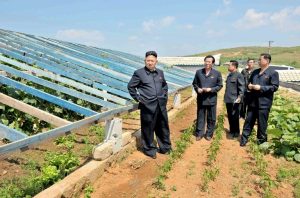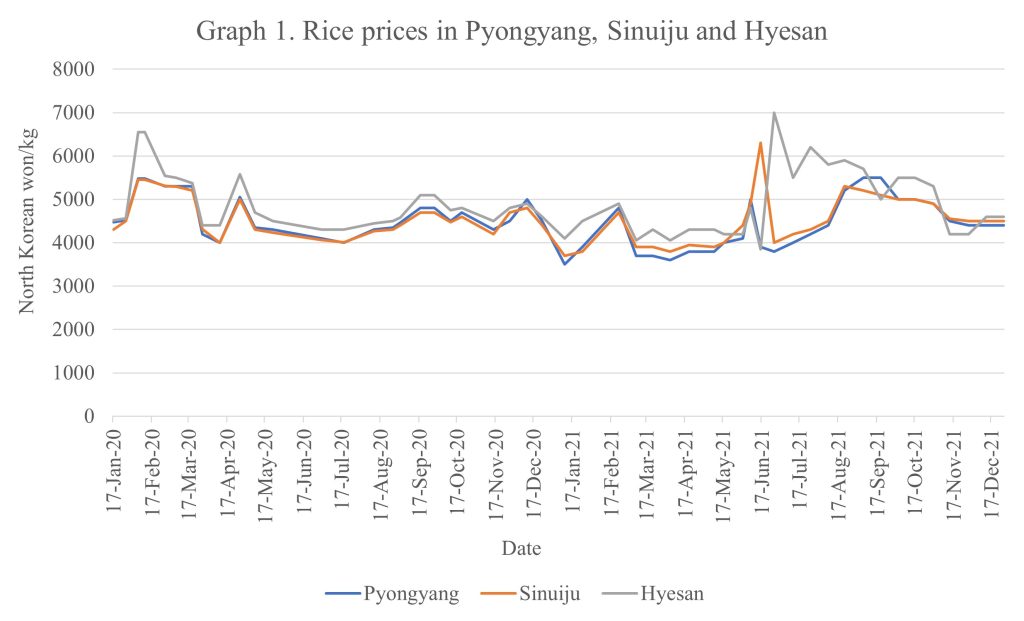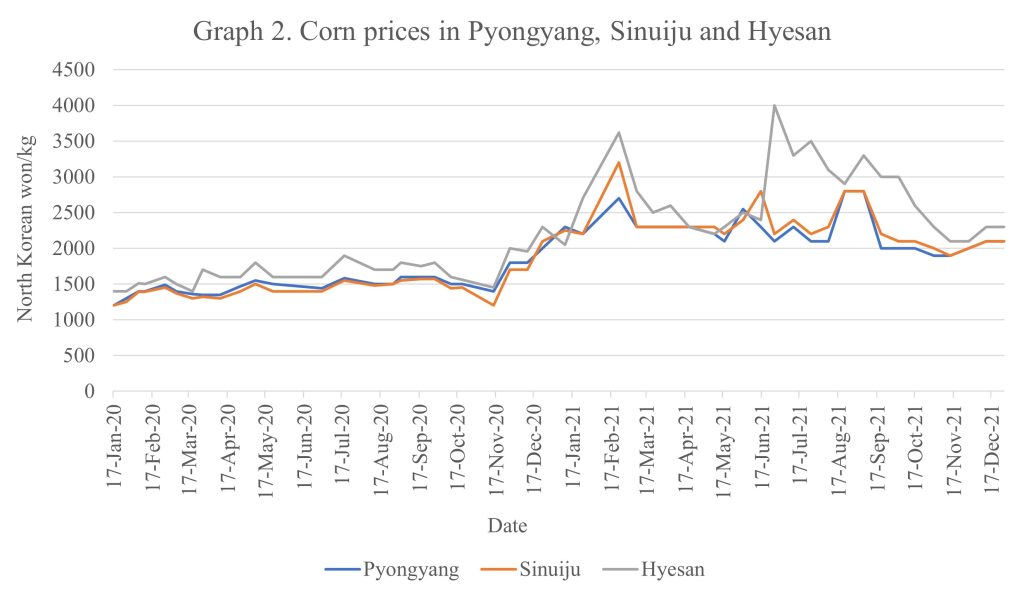The North Korean Economy in 2021 and 2022: Muddling Through With Few Options

What was the state of the North Korean economy in 2021, and where is it headed in 2022? The Central Committee plenary report published by North Korea on the first day of the year reviewed the economic situation and staked out a direction for the coming year. The report is scarce on details and concrete plans for implementation and, not least, financing for the state’s visions. The goals for this year are ambitious and vague. In 2022, the country will “completely solve the food problem,” rural communities will be refurbished and strengthened in the model of Samjiyon City, and sectors such as coal, cement, construction and metal production are supposed to simply produce more, thereby making the economy grow.[1] In reality, short of drastically relaxing border restrictions, the North Korean economy will likely muddle through and continue its slow decline in 2022.
2021 was one of the most volatile years for the North Korean economy in the last decade. The reliability of market price data from North Korea is complicated at the best of times, and even more so now, given the regime’s tight seal on the border during COVID-19. Nonetheless, a close look at this data suggests that while not at a point of disaster, a considerable part of the population faced an increasingly difficult food situation. This is unlikely to change in the coming year.
Rural Areas and Agriculture: 2021-2022 Price Data Comparisons
Almost half—43 percent—of the 2022 plenary report centered on agriculture and rural communities. This is a natural focus, as most North Koreans outside the elite have presumably noticed food price hikes and consumer goods scarcities in their everyday life. There is a multitude of reasons for this. Although the size of North Korea’s foreign trade is abysmal compared with that of most other countries, key inputs such as agricultural equipment and fertilizer must frequently be imported from abroad. This is also the case for a wide range of industrial goods and inputs that are now largely inaccessible due to the border closure. Moreover, the border closure has made both imports and smuggling of food and other consumer goods often prohibitively difficult.
Some estimates suggest that food production in North Korea actually increased, albeit marginally, in 2021, largely thanks to the absence of major typhoons and other natural disasters. Market price data, however, suggests that food supply has been both volatile and scarce throughout the year, often hitting the northeast particularly hard.
To see why, consider the following graphs:

One striking element is that rice prices, as a whole, remained relatively stable throughout 2020 and 2021, the period of the border closure. Given what we know about the context of food scarcity, however, prices have most likely remained stable because demand has dropped and shifted toward cheaper goods like corn, not because supply has remained constant. The stark difference between Hyesan on the one hand, and Sinuiju and Pyongyang on the other, suggests rife regional disparities in access to food. It also suggests that internal movement may have become considerably more difficult. For several weeks in the summer of 2021, for example, prices were significantly higher in Hyesan and at one point almost double those in Pyongyang. In a market where goods can move freely, we would expect any price gap to close quickly as sellers would respond by supplying more to regions where prices and demand are higher. The price gap eventually narrowed, but for most of the year, prices were consistently higher in Hyesan than elsewhere.

Corn prices through 2020–2021 are arguably the most illustrative and tangible quantitative data for these dynamics. Corn is a crucial indicator since it is a less preferred staple good than rice. Thus, when food is scarce in the system as a whole, consumers are likely to shift more of their consumption to cheaper goods such as corn, increasing demand and driving up prices. From late 2020 and onward, corn prices skyrocketed. In Sinuiju, they rose from 1,200 won/kg in mid-November to 3,200 won/kg in late February, an increase of over 267 percent.
Here, too, conditions appear to have been more difficult Hyesan in the remote northeast than in other parts of the country. Sinuiju is also in the north, but it is much better connected both with China and the rest of North Korea than Hyesan. Corn prices have almost consistently been higher in Hyesan throughout 2021. In late June, the reported corn price in Hyesan was almost double that of Pyongyang, 4,000 won/kg versus Pyongyang’s 2,100 won/kg.
This price data not only suggests that North Korea’s food situation has gotten considerably more fragile in the past year. It also indicates that the troubles may be far from evenly distributed throughout the country. Even in normal times, food tends to be scarcer in the northeast than elsewhere. This is somewhat compensated for by its proximity to China, giving opportunities for both cross-border trade and smuggling. At present, though, this advantage is likely very limited because of the government’s strict border closure.
The price differences between different parts of the country also suggest—though this cannot be verified—that internal market trade may have become more difficult through the year. When market prices diverge drastically between two localities, this suggests that barriers are in place that hinder producers from selling their goods at a comparatively higher price elsewhere. This may be a result of restrictions on movement between provinces and cities to prevent the spread of COVID-19. Although understandable from a disease prevention perspective, such restrictions would be detrimental to the welfare of the general public, as they hinder food from being allocated to places where it is scarcer, and demand is higher.
The Plenary Speech and the Year Ahead
The policies announced in the plenary report are unlikely to change this direction. For the North Korean public, however, two aspects of the report give some cause for cautious optimism.
First, the report suggests that the state will continue seeking to improve its disaster management methods. As previously noted on 38 North, the government has emphasized disaster risk reduction over the past few years and adopted a “National Disaster Risk Reduction Strategy” for 2019–2030. One significant sentence in the plenum report indicated that this priority will continue (author’s emphasis):
What is important is that we became confident in doing safe farming under any condition by adopting scientific methods of responsively reacting to disastrous climates and obstacles though they used to decide good or bad crop, and this is the valuable fruition the credit of which is to the rare patriotism and indomitable efforts of our agricultural workers.[2]
This suggests that the government seeks to strengthen preemptive disaster management measures that, if done right and with the proper resources, could indeed help stabilize the food situation by making harvests less vulnerable to natural disasters. The Korean-language wording seems to highlight preemptive measures even more strongly, using “with foresight (예견성이 있게)” rather than “responsively” in describing measures to counter climactic disasters.
Second, the lack of attacks on officials and the public for anti-socialist tendencies may suggest that the regime is toning down the anti-capitalist campaign it has been waging for the past couple of years. The absence of statements about clamping down even harder on ideological crimes, such as consumption of foreign culture, is not in itself evidence of any change in attitude. At the same time, Kim Jong Un’s Worker’s Party Congress report from early last year was heavily loaded with such pronouncements, and the difference in the plenum report is stark. It is possible to speculate that the state has decided to lessen the pressure of the campaign somewhat, perhaps in response to popular discontent with the increased scrutiny.
Conclusion
In 2021, the North Korean economy experienced serious difficulties but muddled through and avoided a full-scale disaster. In April 2021, Kim Jong Un warned that another “Arduous March,” the regime’s term for the period of economic collapse and famine in the 1990s, might be afoot. This was likely more about managing expectations than a prediction of a full-scale famine, and the plenary report served a similar purpose. The regime does not appear to expect any significant changes in economic conditions over the coming year, making goals both vague and relatively modest. If 2021 is any guide, the economic slump and food scarcity are likely to continue through the current year as well.
